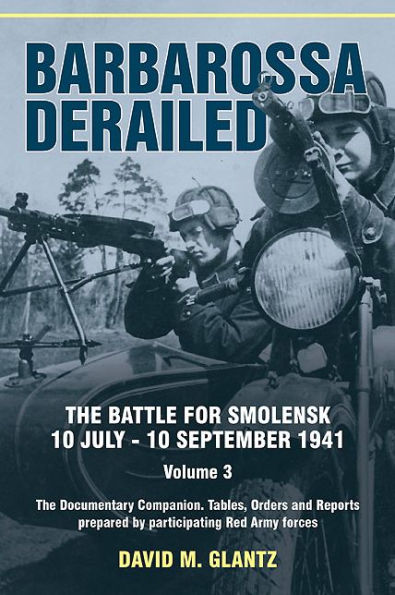Barbarossa Derailed: The Battle for Smolensk 10 July-10 September 1941: Volume 3 - The Documentary Companion. Tables, Orders and Reports prepared by participating Red Army forces
Volume 3, the Documentary Companion to Barbarossa Derailed, contains the documentary evidence for the two volumes of narrative. In addition to key Führer Directives issued by Adolf Hitler to provide direction to his forces during the Barbarossa Campaign, as well as vital orders issued by German Army Group Center, this book includes the daily operational summaries of the participating Soviet fronts, armies, and some divisions and many if not most of the orders and reports issued by the struggling Soviet armies. Precise translations illustrate not only the capabilities and states-of-mind of key Soviet commanders as they dealt with crisis after crisis but also the characteristics (such as aggressiveness, passivity, brutality, and despair) of their varied styles of command. They also demonstrate how an army, which lost the bulk of its experienced troops during the first several months of the campaign, attempted to use its operational directives and tactical orders to educate its soldiers and officers in the basics of waging war in the midst of active and bloody operations.
1117483891
Barbarossa Derailed: The Battle for Smolensk 10 July-10 September 1941: Volume 3 - The Documentary Companion. Tables, Orders and Reports prepared by participating Red Army forces
Volume 3, the Documentary Companion to Barbarossa Derailed, contains the documentary evidence for the two volumes of narrative. In addition to key Führer Directives issued by Adolf Hitler to provide direction to his forces during the Barbarossa Campaign, as well as vital orders issued by German Army Group Center, this book includes the daily operational summaries of the participating Soviet fronts, armies, and some divisions and many if not most of the orders and reports issued by the struggling Soviet armies. Precise translations illustrate not only the capabilities and states-of-mind of key Soviet commanders as they dealt with crisis after crisis but also the characteristics (such as aggressiveness, passivity, brutality, and despair) of their varied styles of command. They also demonstrate how an army, which lost the bulk of its experienced troops during the first several months of the campaign, attempted to use its operational directives and tactical orders to educate its soldiers and officers in the basics of waging war in the midst of active and bloody operations.
89.95
In Stock
5
1

Barbarossa Derailed: The Battle for Smolensk 10 July-10 September 1941: Volume 3 - The Documentary Companion. Tables, Orders and Reports prepared by participating Red Army forces
568
Barbarossa Derailed: The Battle for Smolensk 10 July-10 September 1941: Volume 3 - The Documentary Companion. Tables, Orders and Reports prepared by participating Red Army forces
568Hardcover
$89.95
89.95
In Stock

Product Details
| ISBN-13: | 9781909982116 |
|---|---|
| Publisher: | Helion and Company |
| Publication date: | 10/19/2014 |
| Pages: | 568 |
| Product dimensions: | 6.20(w) x 9.30(h) x 2.40(d) |
About the Author
From the B&N Reads Blog
